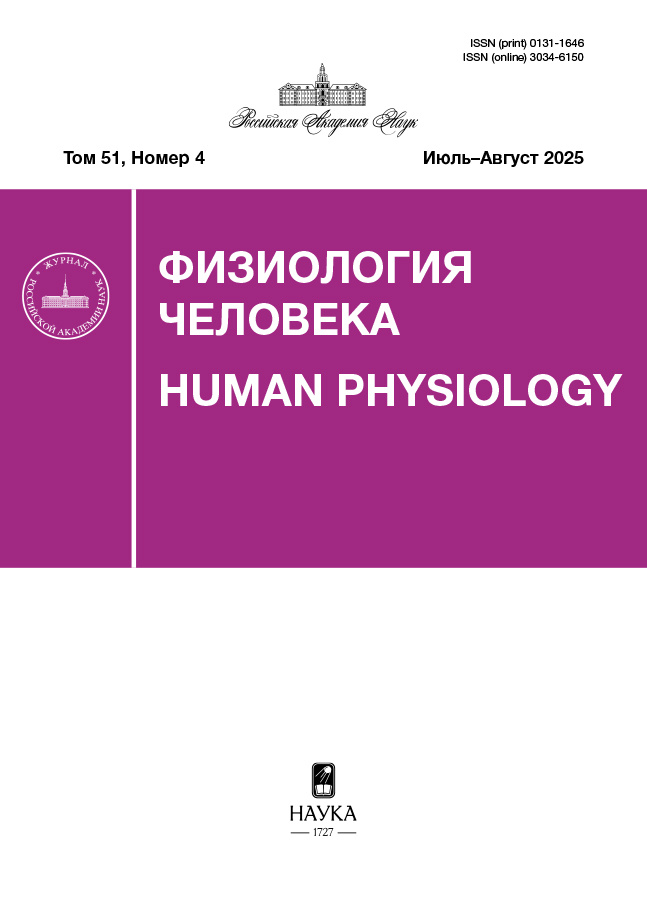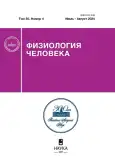The Effect of Long-Term Physical Disability and Aging on Extracellular Matrix Biogenesis in Human Skeletal Muscle
- Authors: Kurochkina N.S.1, Lednev E.M.1, Orlova M.A.1, Vigovskiy M.A.2, Zgoda V.G.3, Vavilov N.E.3, Vepkhvadze T.F.1, Makhnovskii P.A.1, Grigorieva O.A.2, Boroday Y.R.2, Philippov V.V.2, Vyssokikh M.Y.1,2, Efimenko A.Y.2, Popov D.V.1
-
Affiliations:
- Institute of Biomedical Problems of the RAS
- Lomonosov Moscow State University
- Institute of Biomedical Chemistry
- Issue: Vol 50, No 4 (2024)
- Pages: 68-79
- Section: Articles
- URL: https://gynecology.orscience.ru/0131-1646/article/view/664073
- DOI: https://doi.org/10.31857/S0131164624040063
- EDN: https://elibrary.ru/BTJTHU
- ID: 664073
Cite item
Abstract
Physical inactivity and aging cause significant impairments in the functionality and mechanical properties of skeletal muscles, as well as remodeling of the extracellular matrix (ECM). We aimed to study the effect of long-term inactivity and age on the biogenesis of ECM in skeletal muscle. For quantitative mass spectrometry-based proteomic analysis and RNA sequencing, biopsy samples were taken from m. vastus lateralis in 15 young healthy volunteers, 8 young and 37 elderly patients with long-term primary osteoarthritis of the knee/hip joint – which is a model for studying the effects of inactivity on muscles. We detected 1022 mRNAs and 101 ECM and associated proteins (matrisome). An increase in the expression of two dozen highly abundant matrisome proteins, specific to elderly and young patients (in relation to young healthy people), was detected; however, changes in the expression of mRNA encoding matrisome regulators (enzymatic regulators and secreted proteins) were similar. Comparison with previous proteomic and transcriptomic data showed that the changes in the matrisome that we described differed markedly from the changes caused by aerobic physical training in young healthy people, in particular, in the expression of the dominant ECM proteins and, especially, in the expression of mRNA of ECM enzymatic regulators and secreted proteins. Comparison of the changes in the expression profiles of these regulatory genes may be useful for identifying pharmacological targets for the prevention of adverse changes/activation of ECM biogenesis under various pathological conditions/physical training.
Keywords
Full Text
About the authors
N. S. Kurochkina
Institute of Biomedical Problems of the RAS
Author for correspondence.
Email: nadia_sk@mail.ru
Russian Federation, Moscow
E. M. Lednev
Institute of Biomedical Problems of the RAS
Email: nadia_sk@mail.ru
Russian Federation, Moscow
M. A. Orlova
Institute of Biomedical Problems of the RAS
Email: nadia_sk@mail.ru
Russian Federation, Moscow
M. A. Vigovskiy
Lomonosov Moscow State University
Email: nadia_sk@mail.ru
Medical Research and Educational Center
Russian Federation, MoscowV. G. Zgoda
Institute of Biomedical Chemistry
Email: nadia_sk@mail.ru
Russian Federation, Moscow
N. E. Vavilov
Institute of Biomedical Chemistry
Email: nadia_sk@mail.ru
Russian Federation, Moscow
T. F. Vepkhvadze
Institute of Biomedical Problems of the RAS
Email: nadia_sk@mail.ru
Russian Federation, Moscow
P. A. Makhnovskii
Institute of Biomedical Problems of the RAS
Email: nadia_sk@mail.ru
Russian Federation, Moscow
O. A. Grigorieva
Lomonosov Moscow State University
Email: nadia_sk@mail.ru
Medical Research and Educational Center
Russian Federation, MoscowY. R. Boroday
Lomonosov Moscow State University
Email: nadia_sk@mail.ru
Medical Research and Educational Center
Russian Federation, MoscowV. V. Philippov
Lomonosov Moscow State University
Email: nadia_sk@mail.ru
Medical Research and Educational Center
Russian Federation, MoscowM. Yu. Vyssokikh
Institute of Biomedical Problems of the RAS; Lomonosov Moscow State University
Email: nadia_sk@mail.ru
Belozersky Institute of Physico-Chemical Biology
Russian Federation, Moscow; MoscowA. Yu. Efimenko
Lomonosov Moscow State University
Email: nadia_sk@mail.ru
Medical Research and Educational Center
Russian Federation, MoscowD. V. Popov
Institute of Biomedical Problems of the RAS
Email: nadia_sk@mail.ru
Russian Federation, Moscow
References
- Kjaer M. Role of extracellular matrix in adaptation of tendon and skeletal muscle to mechanical loading // Physiol. Rev. 2004. V. 84. № 2. P. 649.
- McKee T.J., Perlman G., Morris M.,Komarova S.V. Extracellular matrix composition of connective tissues: a systematic review and meta-analysis // Sci. Rep. 2019. V. 9. № 1. P. 10542
- Campisi J., Kapahi P., Lithgow G.J. et al. From discoveries in ageing research to therapeutics for healthy ageing // Nature. 2019. V. 571. № 7764. P. 183.
- Lopez-Otin C., Blasco M.A., Partridge L. et al. Hallmarks of aging: An expanding universe // Cell. 2023. V. 186. № 2. P. 243.
- Furrer R., Handschin C. Drugs, clocks and exercise in ageing: hype and hope, fact and fiction // J. Physiol. 2023. V. 601. № 11. P. 2057.
- Marcucci L., Reggiani C. Increase of resting muscle stiffness, a less considered component of age-related skeletal muscle impairment // Eur. J. Transl. Myol. 2020. V. 30. № 2. P. 8982.
- Pavan P., Monti E., Bondi M. et al. Alterations of extracellular matrix mechanical properties contribute to age-related functional impairment of human skeletal muscles // Int. J. Mol. Sci. 2020. V. 21. № 11. P. 3992.
- Wood L.K., Kayupov E., Gumucio J.P. et al. Intrinsic stiffness of extracellular matrix increases with age in skeletal muscles of mice // J. Appl. Physiol. 2014. V. 117. № 4. P. 363.
- Olson L.C., Redden J.T., Schwartz Z. et al. Advanced glycation end-products in skeletal muscle aging // Bioengineering (Basel). 2021. V. 8. № 11. P. 168.
- Fede C., Fan C., Pirri C. et al. The Effects of Aging on the Intramuscular Connective Tissue // Int. J. Mol. Sci. 2022. V. 23. № 19. P. 11061.
- Ubaida-Mohien C., Lyashkov A., Gonzalez-Freire M. et al. Discovery proteomics in aging human skeletal muscle finds change in spliceosome, immunity, proteostasis and mitochondria // Elife. 2019. V. 8. P. e49874.
- Nederveen J.P., Joanisse S., Thomas A.C.Q. et al. Age-related changes to the satellite cell niche are associated with reduced activation following exercise // FASEB. J. 2020. V. 34. № 7. P. 8975.
- Haus J.M., Carrithers J.A., Trappe S.W., Trappe T.A. Collagen, cross-linking, and advanced glycation end products in aging human skeletal muscle // J. Appl. Physiol. (1985). 2007. V. 103. № 6. P. 2068.
- Mavropalias G., Boppart M., Usher K.M. et al. Exercise builds the scaffold of life: muscle extracellular matrix biomarker responses to physical activity, inactivity, and aging // Biol. Rev. Camb. Philos. Soc. 2023. V. 98. № 2. P. 481.
- Murgia M., Toniolo L., Nagaraj N. et al. Single muscle fiber proteomics reveals fiber-type-specific features of human muscle aging // Cell. Rep. 2017. V. 19. № 11. P. 2396.
- Kurochkina N.S., Orlova M.A., Vigovskiy M.A. et al. Age-related changes in human skeletal muscle transcriptome and proteome are more affected by chronic inflammation and physical inactivity than primary aging // Aging. Cell. 2024. № 4. P. e14098.
- Lofaro F.D., Cisterna B., Lacavalla M.A. et al. Age-related changes in the matrisome of the mouse skeletal muscle // Int. J. Mol. Sci. 2021. V. 22. № 19. P. 10564.
- Suetta C., Aagaard P., Magnusson S.P. et al. Muscle size, neuromuscular activation, and rapid force characteristics in elderly men and women: effects of unilateral long-term disuse due to hip-osteoarthritis // J. Appl. Physiol. 2007. V. 102. № 3. P. 942.
- Callahan D.M., Miller M.S., Sweeny A.P. et al. Muscle disuse alters skeletal muscle contractile function at the molecular and cellular levels in older adult humans in a sex-specific manner // J. Physiol. 2014. V. 592. № 20. P. 4555.
- Callahan D.M., Tourville T.W., Miller M.S. et al. Chronic disuse and skeletal muscle structure in older adults: sex-specific differences and relationships to contractile function // Am. J. Physiol. Cell. Physiol. 2015. V. 308. № 11. P. 932.
- Miller M.S., Callahan D.M., Tourville T.W. et al. Moderate-intensity resistance exercise alters skeletal muscle molecular and cellular structure and function in inactive older adults with knee osteoarthritis // J. Appl. Physiol. 2017. V. 122. № 4. P. 775.
- Shao X., Taha I.N., Clauser K.R. et al. MatrisomeDB: the ECM-protein knowledge database // Nucleic. Acids. Res. 2020. V. 48. № D1. P. D1136.
- Lednev E.M., Lysenko E.A., Zgoda V.G. et al. Eight-week aerobic training activates extracellular matrix biogenesis in human skeletal muscle // Human Physiology. 2023. V. 49. № 2. P. 129.
- Ware J., Jr., Kosinski M., Keller S.D. A 12-Item Short-Form Health Survey: construction of scales and preliminary tests of reliability and validity // Med. Care. 1996. V. 34. № 3. P. 220.
- Popov D.V., Vinogradova O.L., Zgoda V.G. Preparation of human skeletal muscle samples for proteomic analysis with isobaric iTRAQ labels // Mol. Biol. 2019. V. 53. № 4. P. 606.
- Mays P.K., McAnulty R.J., Campa J.S., Laurent G.J. Age-related changes in collagen synthesis and degradation in rat tissues. Importance of degradation of newly synthesized collagen in regulating collagen production // Biochem. J. 1991. V. 276. № 2. P. 307.
- Kanazawa Y., Ikegami K., Sujino M. et al. Effects of aging on basement membrane of the soleus muscle during recovery following disuse atrophy in rats // Exp. Gerontol. 2017. V. 98. P. 153.
- Kovanen V., Suominen H., Risteli J., Risteli L. Type IV collagen and laminin in slow and fast skeletal muscle in rats--effects of age and life-time endurance training // Coll. Relat. Res. 1988. V. 8. № 2. P. 145.
- Thot G.K., Berwanger C., Mulder E. et al. Effects of long-term immobilisation on endomysium of the soleus muscle in humans // Exp. Physiol. 2021. V. 106. № 10. P. 2038.
- Gonzalez M.N., de Mello W., Butler-Browne G.S. et al. HGF potentiates extracellular matrix-driven migration of human myoblasts: involvement of matrix metalloproteinases and MAPK/ERK pathway // Skelet. Muscle. 2017. V. 7. № 1. P. 20.
- Karalaki M., Fili S., Philippou A., Koutsilieris M. Muscle regeneration: cellular and molecular events // In Vivo. 2009. V. 23. № 5. P. 779.
- Heinemeier K.M., Mackey A.L., Doessing S. et al. GH/IGF-I axis and matrix adaptation of the musculotendinous tissue to exercise in humans // Scand. J. Med. Sci. Sports. 2012. V. 22. № 4. P. e1.
- Torrente Y., Bella P., Tripodi L. et al. Role of insulin-like growth factor receptor 2 across muscle homeostasis: Implications for treating muscular dystrophy // Cells. 2020. V. 9. № 2. P. 441.
- Ikutomo M., Sakakima H., Matsuda F., Yoshida Y. Midkine-deficient mice delayed degeneration and regeneration after skeletal muscle injury // Acta. Histochem. 2014. V. 116. № 2. P. 319.
- Jones J.C., Kroscher K.A., Dilger A.C. Reductions in expression of growth regulating genes in skeletal muscle with age in wild type and myostatin null mice // BMC. Physiol. 2014. V. 14. P. 3.
- Duffy F.J., Jr., Seiler J.G., Gelberman R.H., Hergrueter C.A. Growth factors and canine flexor tendon healing: initial studies in uninjured and repair models // J. Hand. Surg. Am. 1995. V. 20. № 4. P. 645.
- Chen C.P., Yang Y.C., Su T.H. et al. Hypoxia and transforming growth factor-beta 1 act independently to increase extracellular matrix production by placental fibroblasts // J. Clin. Endocrinol. Metab. 2005. V. 90. № 2. P. 1083.
- Arai K.Y., Nishiyama T. Developmental changes in extracellular matrix messenger RNAs in the mouse placenta during the second half of pregnancy: possible factors involved in the regulation of placental extracellular matrix expression // Biol. Reprod. 2007. V. 77. № 6. P. 923.
Supplementary files











